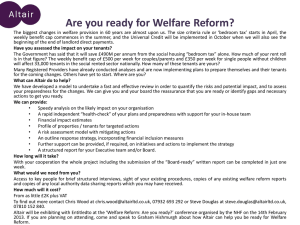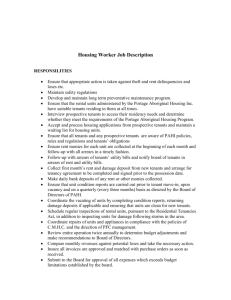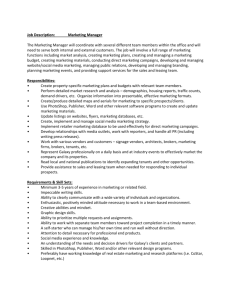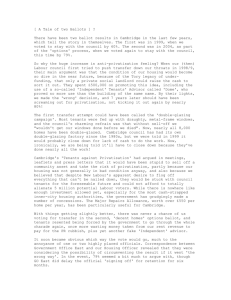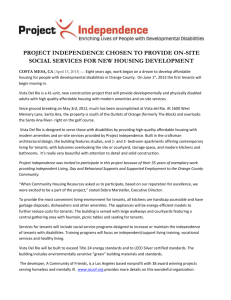Note Title - Energypedia
advertisement
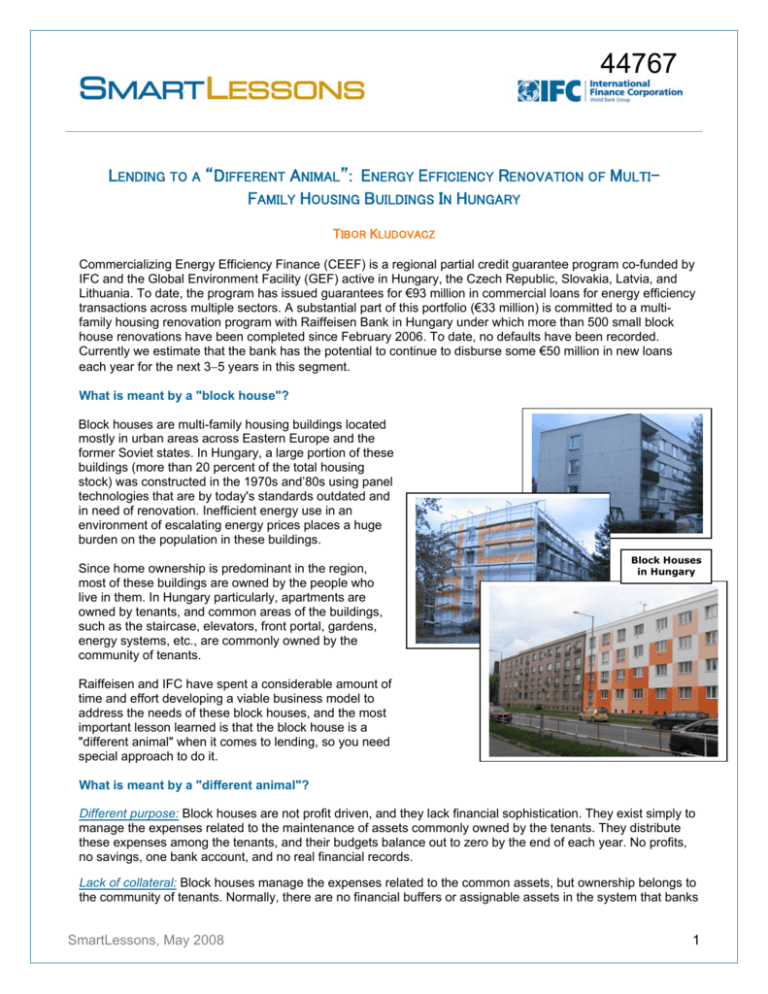
44767 LENDING TO A “DIFFERENT ANIMAL”: ENERGY EFFICIENCY RENOVATION OF MULTIFAMILY HOUSING BUILDINGS IN HUNGARY TIBOR KLUDOVACZ Commercializing Energy Efficiency Finance (CEEF) is a regional partial credit guarantee program co-funded by IFC and the Global Environment Facility (GEF) active in Hungary, the Czech Republic, Slovakia, Latvia, and Lithuania. To date, the program has issued guarantees for €93 million in commercial loans for energy efficiency transactions across multiple sectors. A substantial part of this portfolio (€33 million) is committed to a multifamily housing renovation program with Raiffeisen Bank in Hungary under which more than 500 small block house renovations have been completed since February 2006. To date, no defaults have been recorded. Currently we estimate that the bank has the potential to continue to disburse some €50 million in new loans each year for the next 3−5 years in this segment. What is meant by a "block house"? Block houses are multi-family housing buildings located mostly in urban areas across Eastern Europe and the former Soviet states. In Hungary, a large portion of these buildings (more than 20 percent of the total housing stock) was constructed in the 1970s and’80s using panel technologies that are by today's standards outdated and in need of renovation. Inefficient energy use in an environment of escalating energy prices places a huge burden on the population in these buildings. Since home ownership is predominant in the region, most of these buildings are owned by the people who live in them. In Hungary particularly, apartments are owned by tenants, and common areas of the buildings, such as the staircase, elevators, front portal, gardens, energy systems, etc., are commonly owned by the community of tenants. Block Houses in Hungary Raiffeisen and IFC have spent a considerable amount of time and effort developing a viable business model to address the needs of these block houses, and the most important lesson learned is that the block house is a "different animal" when it comes to lending, so you need special approach to do it. What is meant by a "different animal"? Different purpose: Block houses are not profit driven, and they lack financial sophistication. They exist simply to manage the expenses related to the maintenance of assets commonly owned by the tenants. They distribute these expenses among the tenants, and their budgets balance out to zero by the end of each year. No profits, no savings, one bank account, and no real financial records. Lack of collateral: Block houses manage the expenses related to the common assets, but ownership belongs to the community of tenants. Normally, there are no financial buffers or assignable assets in the system that banks SmartLessons, May 2008 1 could get access to. Designing a financial scheme with recourse to tenants is not an option, since by lending at the tenants’ level instead of at the condominium level banks would lose scale and have to deal with a credit review of a much larger number of individual households. A problematic decision-making process: Each decision, especially ones relating to entering into a long-term loan agreement, requires the consensus of many people. This is difficult and lengthy to arrive at. Furthermore, there is a serious mismatch between the beneficiaries of the loan (the individual tenants) and the entity that is responsible for repaying the loan (the block house). Lack of financial skills: Block houses tend to have one employee only – usually a tenant who has some free time – but without necessarily any specific financial skills. The banks need to find a new language to communicate with these clients. Lesson No. 1 – Existence of a few enabling factors Aggregator with a legal format: Tenants of the building must form some kind of legal entity that gets its mandate from them and acts on their behalf. This unit can be viewed as an "aggregator" as it groups together the interests and financial strength of the tenants of the building to achieve economy of scale. The aggregator needs to have a legal format, and its operations need to be subject to enforceable regulations so that banks can lend to them. Without the aggregator, banks can only lend to the individual tenants, but that's not block house lending. In Hungary, tenants of multi-apartment buildings are required by law to form legal entities called "housing associations" for the management of the commonly owned assets of the building. This regulation is quite common in many other countries as well. Housing associations are similar to private companies in the sense that they can enter into all sorts of agreements and can be taken to court if they do not meet their obligations. The aggregator concept also works in markets where regulation similar to the Hungarian model does not exist. The aggregator can simply be established by the voluntary action of the tenants, or it could be a utility or any other company that has a billing relationship with the tenants. In countries where the enabling environment is absent, however, advisory services can help the governments develop the favorable legal framework. Periodical contributions from tenants to the aggregator: There must be a financial link between the tenants and the aggregator to ensure that tenants are funding the operations of the aggregator. The aggregator must also have leverage to enforce payment of such contributions. In Hungary, tenants of multi-apartment buildings are obliged by law to contribute financially on a monthly basis ("common cost payments") just by the fact that they own property in the building. The regulator even determines the minimal level of these contributions. And housing associations have a powerful tool in their hands to enforce payments: they have the right to originate mortgage on the property of nonpayers. It is not necessary, however, for this funding obligation of tenants toward the aggregator to be assigned to the bank in a loan setting. In fact, loans to housing associations are non-recourse to tenants in Hungary. If a housing association defaults under a loan agreement, the bank does not have the right to go after the tenants. They can only go after the association, and it's the association's responsibility to collect from tenants. Taking into account that even extreme common cost overdues are still just a small fraction of the value of the apartments, the associations' right to exercise mortgage ensures a strong common cost payment discipline. Demand: One of the key drivers of the market is the demand from tenants. In Hungary almost 70 percent of the multi-apartment buildings were built 30−50 years previously, back in the Soviet era, and they contain oldfashioned, inefficient technology. The increasing cost of energy is drawing attention to energy efficiency, and energy benefits are maximized if tenants act as a community and address the whole building envelope. Furthermore, by renovating the buildings, not only do the tenants benefit from better insulation and more costefficient energy use, but the value of their property increases and the quality of their living environment improves. Availability of technical solutions locally: A wide range of relatively cheap and simple technology should be available locally, from building envelope insulation upgrades (including window replacement) to internal renovation of the heat distribution network (heat exchangers, pipes, radiators, etc.) and installation of heat SmartLessons, May 2008 2 regulation and metering devices to allow tenants to manage their consumption. Existence of well-supplied and qualified local contractors is also a must for low-cost, high-quality services. Lesson No. 2 – Creative financial structuring Cash-flow−based lending: Raiffeisen realized that if asset-backed lending concepts weren't the answer (as housing associations don't normally own assets), then cash-flow−based lending would have to be applied. With housing associations, the only periodical cash flow available is the common cost payments of tenants, so the bank did two things: 1) they made sure they had access to this cash flow; and 2) they made sure the cash flow was big enough to amortize the loan. A lending scheme was implemented that required the association to put in place a valid decision of the assembly of tenants to increase their monthly common cost payment obligation to a level where on aggregate they cover the monthly installments of the loan. It is up to the housing association to determine how this obligation is distributed among the tenants. This is then assigned and channeled through the bank on a monthly basis for debt service. IFC guarantees for collateral: To address the lack of collateral, IFC guarantees were added to the equation. IFC's product was designed along the principle of making sure that the bank's and IFC's interests are aligned and each party is comfortable with the risks taken. The product offered was a portfolio level 50/50 pari passu risk-sharing between the bank and IFC. A special incentive of a small first loss account (up to 2 percent) funded by the GEF is also provided to the bank to cover subordinated risk obligations. This first loss incentive is gradually decreasing to zero as the bank gains experience with the market. Apart from the IFC guarantee, the only collateral the bank has is a drawing right on the account(s) of the block house. The bank is also offering 100 percent debt financing without any equity requirement. Character-based credit review: Block houses are not after profit, and their financial reports are basically simple expense/income statements. There was no point for Raiffeisen to base its credit review on financials. In fact, Raiffeisen doesn't even need these reports during the appraisal process. Instead, the bank is relying on 1) past payment history of the block houses, including the tenants’ payment record and the association's past discipline of paying bills for services purchased, utility bills, tax authority obligations, etc; and 2) the validity of the common decision regarding the investment, whereby the bank makes sure that the decision of tenants to enter into a loan as well as to increase the monthly common costs is adequate, legally binding, and enforceable for each tenant involved. In case there are reasons to raise issues with the past records of block houses, various types of deposit requirements kick in, and there's absolutely no loan unless the decision of the tenants is in place in a manner and format satisfactory to Raiffeisen. Application of available grant programs: Being a key social issue, the housing sector will always be in the forefront of the attention of governments. This usually translates into various types of support programs. Incorporating these into the financing scheme opens the door to a larger number of clients. The Hungarian market has many such programs. Three were actually integrated: (1) a nonrefundable state grant up to two-thirds of the total investment amount; (2) an interest subsidy program whereby the state covers a certain percentage of the interest charged by the bank; and (3) a state grant program complementing the savings of tenants if channeled through Building Savings Fund institutions. Since most of these programs require tendering, their use is optional. While it is hard to deny that these grant programs played a significant role in the expansion of the portfolio, their availability is not a precondition to requiring similar facilities. As long as they are available, clients will always want to use them, but the structure is still viable without them. CEEF has done many projects with grants incorporated but also many without any, thus showcasing that the financing scheme can be applied without subsidies. Lesson No. 3 – Standardization Streamlining procedures: When lending involves a large number of tiny yet similar transactions, the natural choice is to standardize and streamline your operations as much as you can. Raiffeisen developed low transaction cost procedures based on simple checklists and predetermined boundary conditions. All transactions that meet the eligibility criteria make it into the portfolio automatically. IFC's guarantee product was designed to meet the same requirements. Underwriting is based on pre-agreed criteria and is fully delegated to SmartLessons, May 2008 3 the bank. Meeting eligibility criteria is entirely the responsibility of the bank. It is verified by IFC only in case of guarantee calls. The bank is also required to report to IFC on a quarterly basis. Monitoring energy savings: This is actually a very problematic area, because Raiffeisen was not willing to take on the responsibility of investigating the engineering eligibility of transactions because of a lack of internal capacity. Subcontracting it is time consuming and cost-intensive, and contradicts the concept of standardization. However, there must be a system in place by which the bank and IFC can determine if the loan is financing energy efficiency or not, especially because this information has considerable marketing value. The solution was rather simple. The whole problem was pushed onto the block houses. Raiffeisen requires that the block houses attach an energy audit to their credit application. Also, it was determined by IFC that any energy or building engineer listed in the regional Chambers of Commerce is eligible to prepare such audits. Raiffeisen is responsible only for making sure that the audit was done by qualified personnel and that energy benefits reach a certain level, but the bank is not responsible for the quality of the audits. This solution is not ideal, as there will always be a trade-off between the quality of the audits and streamlining. This is quite typical for the retail type of energy efficiency programs. The better the audits, the more they slow down projects or even exclude block houses unable to bear the costs. The goal is always to find the right balance of making sure that what we call energy efficiency really is energy efficiency, without overburdening the deal with additional transaction costs. Lesson No. 4 – Creative marketing One of the most important factors in developing block house lending into a mainstream business line was Raiffeisen's creativity in designing and implementing marketing programs. Many banks are offering the same financial product in Hungary, yet Raiffeisen is still the only bank able to generate substantial pipeline. Educate your clients: The bank has been conducting several types of workshops, seminars, road shows, and client events in all major cities of the country. The events are aimed at not only distributing information about the product but also educating housing representatives about basic financials, explaining to them how to apply, what documentation is needed, how to manage the loan during the tenure, etc. The bank even went so far as to create the templates for all required documents. IFC has continuously supported this effort by participating in the events and providing financial support from CEEF's advisory services budget for them. Agent networks: A major thing that set Raiffeisen apart from its competitors is its ability to develop a wide network of agents selling Raiffeisen's credits door to door. The bank has formed partnerships with institutions and companies that are traditionally active in the sector and uses them to extend its outreach to potential clients. They work with a number of project developers and contractors that are therefore able to attach financing to the equipment they sell. They are also using the agent network of Building Savings Funds and insurance companies. These agents provide opportunities for all parties to effectively cross-sell their brands. Each housing renovation program contains loan, insurance, and in many cases a savings fund component, and therefore they all can sell their products with one visit to the client. Word spreads like wildfire: Another quite unexpected aiding factor has been the high visibility of the renovated buildings. Word on the availability of financing spreads like wildfire among tenants when they see the renovated buildings in their area. About the Author Tibor Kludovacz is Program Officer for Environment Sustainable Finance and is based in Budapest, Hungary. Approving Manager: Ajay Narayanan, head of the Environmental Sustainable Finance Group (CGFEN), Global Financial Markets Department. DISCLAIMER IFC SmartLessons is an awards program to share lessons learned in development-oriented advisory services and investment operations. The findings, interpretations, and conclusions expressed in this paper are those of the author(s) and do not necessarily reflect the views of IFC or its partner organizations, the Executive Directors of The World Bank or the governments they represent. IFC does not assume any responsibility for the completeness or accuracy of the information contained in this document. Please see the terms and conditions at www.ifc.org/smartlessons or contact the program at smartlessons@ifc.org. SmartLessons, May 2008 4
